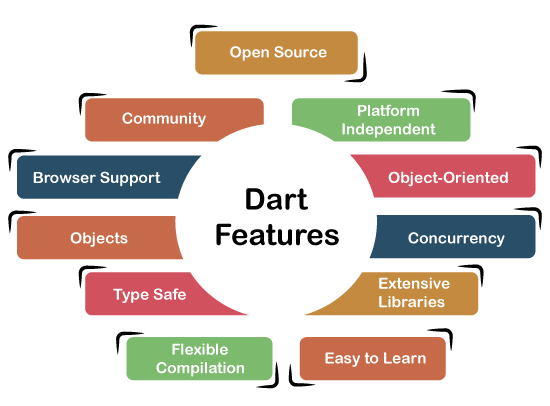Dart Features
Open-source, object-oriented Dart is a programming language with numerous practical features. It is a new programming language that supports several programming features, including dynamic typing, classes, interfaces, collections, and optional typing. It is created for both the browser and the server. The list of crucial Dart features is shown below.

Open Source
Since Dart is an open-source programming language, it can be downloaded for free. It is BSD licensed, developed by Google, and recognized by the ECMA standard.
Platform Independent
Every major operating system, including Windows, Linux, Macintosh, etc., is supported by Dart. We are able to run the Dart code on any operating system thanks to the Dart Virtual Machine (Dart VM).
Object-Oriented
Programming in Dart is object-oriented, and it supports all of the basic principles, including inheritance, classes, interfaces, and optional typing capabilities. Advanced ideas like classes, reified generics, abstract, mixins, and robust type systems are also supported.
Concurrency
Given that Dart is an asynchronous programming language, it can support many threads through the use of isolates. Isolates are autonomous entities that are connected to threads but do not share memory. Message passing is used to establish communication between processes. For the message to be communicated effectively, it should be serialized. Using a snapshot created by the specified object, the message is serialized and then sent to another isolation for desterilization.
Extensive Libraries
A number of helpful built-in libraries are included in Dart, such as the SDK (Software Development Kit), core, math, async, math, convert, html, and IO. It also offers the ability to namespace and organize the Dart code into libraries. By using the import statement, it is reusable.
Easy to learn
Since Dart’s grammar is comparable to that of Java, C#, JavaScript, Kotlin, and other programming languages, as we covered in the previous part, learning the language is not an impossible endeavor. The Dart language is simple to learn if you are familiar with any of these languages.
Flexible Compilation
Dart offers rapid code compilation along with flexibility. It is compatible with AOT (Ahead of Time) and JIT (Just-in-Time) compilation processes. The other language that is supported by contemporary web browsers is used to convey the Dart code.
Type Safe
As a type-safe language, Dart uses both runtime and static type checking to ensure that a variable’s value always corresponds to its static type. This process is frequently referred to as “sound typing.”
Type annotations are optional despite the requirement for types due to type interference. As a result, the code is easier to read. Another benefit of using a type-safe language is that it alerts us when we make changes to a section of code that we have already altered.
Objects
Everything is viewed as an object by the Dart. An object is the value that the variable is assigned. In Dart, strings, integers, and functions are also considered objects. Every object derives from the class Object.
Browser Support
All current web browsers are supported by the Dart. Included with it is the dart2js compiler, which translates Dart code into JavaScript that is optimized for all major web browsers.
Community
There is a sizable Dart community worldwide. It is therefore simple to get assistance if you run into problems when coding. The committed group of developers is trying to improve its functioning.
We have covered the key components of the Dart language here. In the next tutorials, we’ll cover more Dart language principles.
